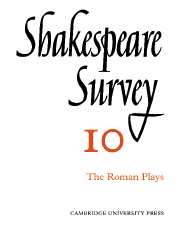Book contents
- Frontmatter
- Shakespeare’s Roman Plays: 1900–1956
- Shakespeare’s ‘Small Latin’—How Much?
- Shakespeare and the Elizabethan Romans
- The Metamorphosis of Violence in Titus Andronicus
- From Plutarch to Shakespeare: A Study of Coriolanus
- The Composition of Titus Andronicus
- Classical Costume in Shakespearian Productions
- Shakespeare’s Use of a Gallery over the Stage
- Lear’s Questions
- “Egregiously an Ass”: The Dark Side of the Moor. A view of Othello’s Mind
- Shakespeare in Schools
- Shakespeare Festival, Toronto, Canada
- International Notes
- Shakespeare Productions in the United Kingdom: 1955
- Drams of Eale, A Review of Recent Productions
- The Year's Contributions to Shakespearian Study 1 Critical Studies
- 2 Shakespeare’s Life, Times and Stage
- 3 Textual Studies
- Books Received
- Index
- Plate Section
Drams of Eale, A Review of Recent Productions
Published online by Cambridge University Press: 28 March 2007
- Frontmatter
- Shakespeare’s Roman Plays: 1900–1956
- Shakespeare’s ‘Small Latin’—How Much?
- Shakespeare and the Elizabethan Romans
- The Metamorphosis of Violence in Titus Andronicus
- From Plutarch to Shakespeare: A Study of Coriolanus
- The Composition of Titus Andronicus
- Classical Costume in Shakespearian Productions
- Shakespeare’s Use of a Gallery over the Stage
- Lear’s Questions
- “Egregiously an Ass”: The Dark Side of the Moor. A view of Othello’s Mind
- Shakespeare in Schools
- Shakespeare Festival, Toronto, Canada
- International Notes
- Shakespeare Productions in the United Kingdom: 1955
- Drams of Eale, A Review of Recent Productions
- The Year's Contributions to Shakespearian Study 1 Critical Studies
- 2 Shakespeare’s Life, Times and Stage
- 3 Textual Studies
- Books Received
- Index
- Plate Section
Summary
Their virtues else—be they as pure as grace,
As infinite as man may undergo—
Shall in the general censure take corruption
From that particular fault: the dram of evil
Doth all the noble substance of a doubt
To his own scandal.
Hamlet's analysis applies to productions of Shakespeare as well as to men. The 1955-6 season promised marvels and in performance displayed an infinity of individual virtues. And yet the total impression was one of disappointment. There was always a dram of evil that finally undermined the most notable production.
Peter Brook's Titus Andronicus at Stratford (which came too late for inclusion in my last report) was certainly that. Brook had not only produced the play but had designed scenery, costumes and musical accompaniment, and he achieved a quite extraordinary unity and concentration of effect. The staging was powerfully simple: three great squared pillars, set angle-on to the audience, fluted, and bronzy-grey in colour (Plate VA). The two visible sides could be swung back, revealing inner recesses that might be used as entrances or, in the central pillar, as a two-storeyed inner stage. This was the tomb of the Andronici, sombre and shadowy against the vivid green of the priests' robes and mushroom-hats; festooned with lianes it became the murder-pit and the forest floor above it; stained a yellowish natural-wood colour it provided a background of Roman frugality to the bereaved and brooding Titus at his family table; bloodred, it made a macabre eyrie of the upper chamber from which the Revenger peers out upon his victims, come in fantastic disguise to entrap him. In the court scenes the closed pillars, supported by heavy side-gratings of the same colour and hangings of purple and green, richly suggested the civilized barbarity of late imperial Rome.
- Type
- Chapter
- Information
- Shakespeare Survey , pp. 126 - 134Publisher: Cambridge University PressPrint publication year: 1957

